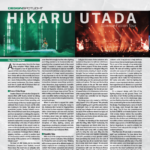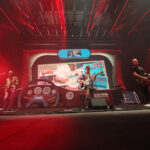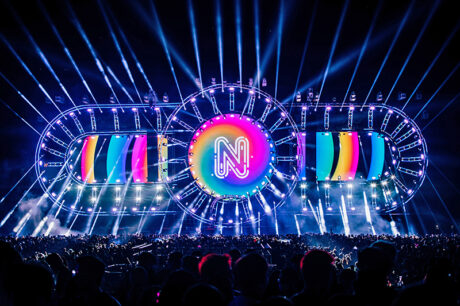
Designers Collyns Stenzel and Ed Shaw Turn In a Remote Design
The end of 2022 saw the return of Neon Countdown, a three day festival held at Wonder World Extreme Park in Bangkok, Thailand. Taking place December 30, 31, 2022 and January 1, 2023, this incarnation of Neon Countdown featured some of the biggest names in EDM including Martin Garrix, DVLM, Armin van Buuren, and more. Neon Countdown got started in Malaysia in 2015 before moving to Thailand. Neon events have been held in over three countries; including being the only EDM festival to be held at the iconic Bird’s Nest Stadium in Beijing.
The producer, and supplier of the lighting, video, and audio, Malaysia-based D8 had previously designed, built, and run a few major festivals around the region. Having recently opened an operation in Thailand, D8 brought on board the Morrison, CO-based Collyns Design, Inc. [www.collynsdesign.com] and 36NORTH [https://36north.group/] out of Las Vegas, to do the lighting and production design for this year’s Neon Countdown. 36NORTH’s Ed Shaw, whose background is in video and VJing, had worked with D8 for over a decade including the Neon Music Festival that was held at Beijing’s Birds Nest Stadium in September 2018. Collyns Stenzel, principal of Collyns Design, is a Lighting Designer and Technical Director who met Shaw, both working with deadmau5. Shaw and Stenzel also recently collaborated on designing Kx5. PLSN spoke with both of them about providing remote design services for Neon Countdown from the U.S.
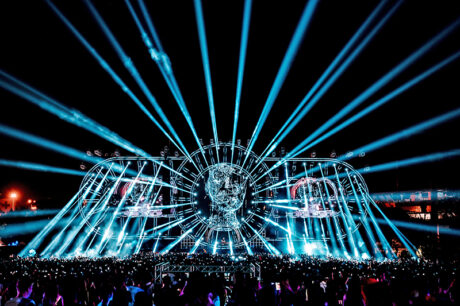
Design Scope
Stenzel and Shaw’s scope of work included the conceptual design, and the “actual deployable design, drafting for engineering, and then 3D files, the pixel map, and all that good stuff,” explains Stenzel, “for lighting and video. We actually did the placement for the lasers and pyrotechnics as well.” When it came to the parameters from the festival, they were pretty loose according to Shaw. “It was quite an open brief to be honest with you,” he says. “They showed us what had been done before and they gave us the dimensions they were working with. So, it was quite an open book really.”
An early little hiccup of working remote meant that sometimes the details get missed in a call. “The final design was a reduced version of what I first did, because I had forgotten how large they wanted it from the call,” laughs Stenzel. “I designed this massive 150-meter long stage and Ed goes, ‘I think that’s too big. You’re going to have to slim that down.’” “We ended up at 45m wide by 27m high when the stage was raised up,” recalls Shaw. “Yeah, so I scaled down this concept of three jet fighter / star ship engines and melded it into one unit. I had the center circular fuselage and this kind of elongated oval on either side to bring it all into one cohesive element.” Stenzel actually produced two versions of the design for the Neon Countdown team to consider. “We created a second option for them, so they would have an A and a B contrast,” explains Stenzel. “The A version was the one I just described and the B version was this kind of blocky structure, still really cool, and had depth happening with it, but it was what people have seen before, however it was way easier to build. Happily, they really liked the A version, and were willing to go with the more challenging design.” The set itself was built out of F-44 global-style truss.
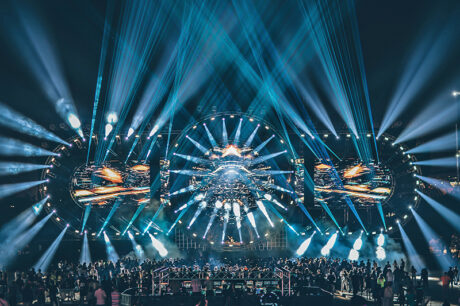
Keeping it Simple
When it came time to choose lighting equipment for the design, LED tape was one of the first considerations. “Well, the obvious thing was a neon look to reinforce the theme, so LED pixel tape was the first consideration,” comments Stenzel. “Pixel tape was a big implementation in the design, and it was something that we were very adamant about them keeping. Usually in design, that’s the first thing that gets struck, with someone saying ‘Let’s get rid of that pixel tape. It looks like it’s a pain in the ass.’ We were so happy that they followed through and didn’t cut the pixel tape because it just really brought the whole entire design together. It was great-looking in the end.”
LED strobes, able to do multiple tasks, allow designers flexibility to get more out of the units which Stenzel likes. “Of course, we had pixelated strobes in my design,” he says, “and while I wanted a GLP JDC1 or a CHAUVET Color STRIKE M, they had a Chinese counterpart that they wanted to use, which was accessible to them. So, they actually had something that was implemented in the design, but maybe not the exact fixture, but had many of the features.”
With festival stages, Stenzel is a big believer in keeping to similar fixture types and streamlining the process for visiting designers for all the different acts that play the stage over the three days. He selected a hybrid fixture for everything apart from the LED strobes. Stenzel states, “We wanted to give the different act designers the best of the beam and the spot with the optics to tie it all together. We wanted to keep everything really simple for programmers coming in because we knew some of the LDs and VJs doing the festival and we didn’t want to throw them 40 different fixture types. I would rather keep it with one fixture type and make it easily programmable for everyone’s show. In other festival scenario—especially in the Asia market—they do these big designs, but you end up getting stuck with too many different fixture types. I’ve been to some festivals where they had upwards of 20 or 30 different fixture types for one stage and it’s very difficult to work with coming in. So, for this one, early in the design process, we really stressed that we wanted it to stay with one fixture type for the hybrid, one for the strobe, and maybe a different one for a key light, and then the pixel neon. It was all about keeping it as simple as possible for a touring artist to come in and be able to implement their show.”
For Shaw’s video specs, he had specified a 3.9mm pixel pitch for the center LED screen and 4.9mm pitch for the outer two screens. “They did end up going all with a 4.9mm pitch across all the screens,” says Shaw. “They were IP65 rated LED video screens. The center screen measured 12m x 12m and the two side flanking side screens were 8m x 12m. The center screen was masked off to make it look like a circle that matched the truss circle. The choice of media servers were all down to the touring crews that came through and I believe all of them were using Resolume.” For control there were two MA Lighting grandMA2 consoles to operate the rig.
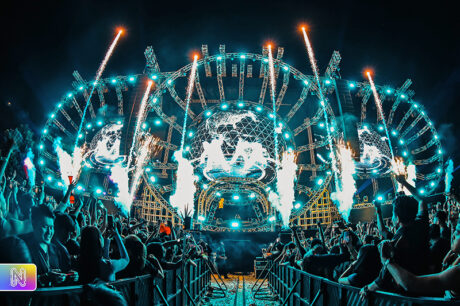
Special FX and Pyro
To ensure that the effects integrated well Stenzel points out that, “In pre-vis, we dealt with placement and wattages of the lasers to make sure that the beams were going to look good with the design. Then for the pyro, we created pyro platforms within the engineering packet that we sent out. This allowed for extra pyro deck replacement, and to make sure none of the gear was going to get smacked with flames. We made an effects area downstage that was 2m deep by 45m wide across the whole front of the stage to keep the pyro from getting inside the show.”
The build took 15 days by local crew and all of the cueing was done locally as well, as neither Shaw nor Stenzel were brought over to the actual show. Shaw comments, “I think a lot of times with shows like this, we would’ve loved to go over there to operate and program. But by the time you’ve got all the different touring crews that come through, they’re programming all the headline shows and most of the support act as well. So it doesn’t make that much sense for a show like this sometimes to bring us over. “ Stenzel adds, “Yeah, it was out of the budget to be able to afford everything and fly us over, which was kind of disappointing, but at the same time a blessing because we all got to stay home for the holidays. We made sure that we gave them really good advance materials, so the acts could came in with confidence. They did change up things a bit from what we had spec’d in the plans but in the end, it was a strong deployment of the design.” Shaw agrees, noting “From the photos we have seen it looks like it worked really well. We are happy with the final results and proud of the design.”
